MF fix focal 105mm – 1200mm
Nikon manual focus fix-focal lenses 105mm to 1200mm
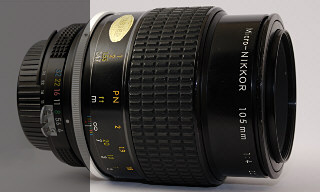
AI 105mm 4.0 Micro
The 105mm f/4.0 Micro Nikkor was the standard macro lens in the Nikkor lineup for a very long time. First it was introduced as a lens which had to be mounted to a bellow in 1969, 1977 it was introduced as a stand-alone AI-lens with a magnification ratio of 1:2. It was replaced by the faster 105mm 2.8 Micro Nikkor in 1983. about 44.000 AI and 23.000 AI-S lenses were produced. The later AI-S lens has a focus lock (silver screw). Price: US (1985): 450 $, Germany (1984): 749 DM, inflation adjusted 2012: 631 €
This lens is designed to perform best in the close focus range. Even at the open aperture of f/4 the lens is as sharp as other lenses only get at their optimum aperture. From f/5.6 on the lens is cutting sharp. Fortget about doing portraits with this lens, even at f/4 it will present every wrinkle and skin impurity to the maximum detail. The lens has a magnification ratio of 1:2 and it achieves a 1:1 ratio with the optional PN-11 extension tube (52,5 mm extension). A magnification scale for use with and without the extension tube is engraved on the lens barrel.
Unfortunately this lens is “only” optimal in the closer range up to 10 metres. At infinity the pictures lack the “punch” that can be achieved with other fix focal lenses. But it is a macro lens after all and you really can’t blame it for being inferior at landscape shooting.
If you have trouble with manual focusing on your DSLR or if you plan to use this lens with exenion tubes most of the time you should think about the successor, the 105mm 2.8 Micro Nikkor. The viewfinder should be considerably brighter due to the larger aperture. For tripod-based work the difference should not matter.
Sample (DX / 6 MP): 105mm f16
Sample (FX / 36 MP): 105mm f5,6

AI 105mm 2.5
A very common lens during the MF era, approximately 500.000 lenses were produced between 1971 and 2005, the later AI-S version (160.000 units) has a built in shade and is optically identical to the AI-version. Price: US (1985): 271 $, Germany (1984): 460 DM, inflation adjusted 2012: 387 €. Avoid the pre-AI models, they are optically different (tessar formula) and not as “creamy” as this version. You can save a few bucks if you have no problems to carry a separate sun shade by buying the AI-version. Great lens with a creamy background blur. Perfect long portrait lens, softer near wide open aperture, good sharpness from f /4.0 on.
Sample (DX / 10 MP): 105mm f4
Samples (FX / 36 MP): 105mm f2,5 105mm f4,0

AI 135mm 2.8
Produced between 1976 and 2005, about 235.000 units. Price: US (1985): 286 $, Germany (1981): 460 DM, inflation adjusted 2012: 431 €. A little bit soft wide open, very good from f/4.0 on. Built in sunshade is a plus. This lens is available on ebay for around 100 Euro, you can also buy the optically slightly different 135mm 2.8 Series E lens. I once picked one up for around 28 Euro and I can not see any big optical difference despite a little different colour temperature. The Series E is also built very well, the only difference is the aperture ring made of plastic instead of metal.
Sample (DX / 6 MP): 135mm f4 (D70, ISO 400)
Sample (FX / 36 MP): 135mm f4,0
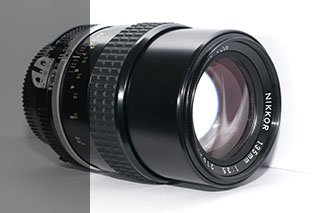
AI 135mm 3.5
On of the first lenses in the Nikon F program and produced between 1959 and 1983 in may different versions, totalling more than 400.000 units. Reviewed here is the AI version from 1977 to 1981 with a big production run of about 100.000 lenses. Price: Germany (1984): 349 DM, inflation adjusted 2012: 294 €.
The lens itself could be easily mistaken for the faster 2,8 AI brother. The outer shape is almost identical. The optical performance is really good and rates surprisingly above that of the 2,8 variant. Color fringing and flare around bright subjects is only a topic at f/3,5 and to a lesser degree at f/4. Color rendering is quite strong and with a lot of contrast.
Sample (FX / 36 MP): 135mm 4,0 135mm 3,5 (worst fringing at an overexposed bright object, that I was able to produce) 135mm 5,6
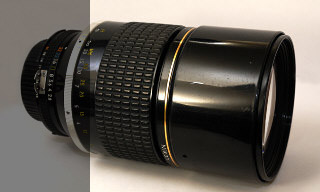
AI-S 180mm 2.8 ED
Introduced in 1969 as non-ED version and equipped with ED glass together with the change to AI-S in 1981. More than 74.000 AI-S lenses were produced. Price: US (1985): 679 $, Germany (1984): 1150 DM, inflation adjusted 2012: 969 €.
Even the non-ED version of this lens has an excellent reputation and the 180mm fix-focal lens is one of the classic lenses in Nikons lineup. The lens has an impressive apearance and a very good optical performance. Sharp wide open (sharper as the AF-D 80-200mm 2.8 at 180mm wide open but less so than the AF-S lens) and razor sharp from f/4. This lens is highly recommended. Lacks a bit of contrast wide open.
Sample (DX / 10 MP): 180mm f4
Sample (FX / 12 MP): 180mm f2,8
Sample (FX / 36 MP): 180mm f2,8 180mm f4,0

AI 200mm 4.0
Produced between 1975 and 1996, about 280.000 lenses. Price: US (1985): 318 $, Germany (1981): 500 DM, inflation adjusted 2012: 469 €. This lens always suffered the strong (and by all means “heavy”) competition of pro-grade 80-200 zooms. Because zooms offered more speed at f/2.8 combined with more range this lens was almost forgotten. Even today you can buy this lens at insane low prices, ranging from 40 Euro to 100 Euro on ebay. For this money you get a pro grade lens regarding construction and optics in a compact, travel-friendly package with a built-in sunshade. Performance is good even at f/4.0 and overall IQ is very good but the contrast is a bit lacking, especially at wider apertures. Stop down to f/8 to get the best results, f/5,6 is very good in most shooting situations, too. On the D200 CA´s are more prominent due to the lack of ED glass that the newer zoom lenses feature, stop down to f8 to minimize colour fringing. Contrary to that on the D700 colour fringing is not a problem at all. The optimizations that Nikon did in this regard with the D300, D3 and D700 generation of cameras comes into play here. Focus can be a little bit tricky due to the reatively dark veiwfinder and because the focus ring throw is a little narrow from 7 metres on. I use this lens as a low-weight alternative to my 80-200 2.8 lens (530 versus 1280 grams). Vignetting is quite visible at f/4 on FX.
Sample (DX / 10 MP): 200mm f8
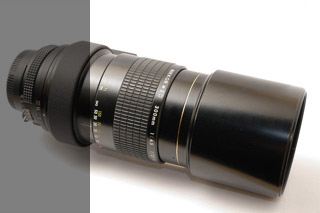
K (AI factory converted) 300mm 4.5 ED non-IF
This lens is often confused with the later 300mm 4,5 IF-ED and this is moslty caused by the relative rarity. Nikon updated the original non-ED version of the lens from the 1960’s in 1977 with an ED glass element and sold it for a short period before the IF-version was introduced. However, the lens got an update from the non-AI “K”-version to genuine AI. Less than 1.000 K and once again 1.000 AI-lenses were produced.
After hunting for this lens for more than two years I was finally able to obtain a sample of the K-version in mint shape. In contrast to the IF-version the focussing requires more force because of the rather high mass that has to be moved with the big internal helicoil. An other difference is the higher weight with a little less than 200g more for the non-IF version. An excellent craftmanship and a solid appearance create a comforting feeling of solidity.
I had to repeat my tests multiple times with this lens because I found it quite hard to beleive what I first saw in comparison with the IF-ED model at wider apertures, especially at f/4,5. The optical performance at f/4,5 is already at a very high level and I would have no hesitation to use the lens only wide open if the DOF area wouldn’t be that small at 300mm. As the lens is being stopped down the performance gap narrows compared to the IF-ED, becoming irrelevant at f/8. Don’t get me wrong: The later IF-ED model is a very good lens but this one surpasses it sharpness-wise in the range from wide open to f/8 quite easily.
Optical performance with teleconvertersis very good, too. Stopped down to f/5,6 the lens performs quite favorably with a 1,4x Kenko TC. Even wide open you can obtain useable images, as the second sample below shows.
Sample (FX / 12 MP): f/4,5 with Kenko 1,4 TC at f/4,5 (so, basically as bad as it can be)
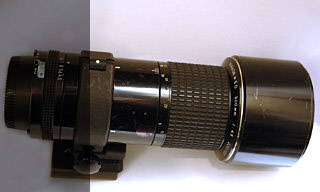
AI 300mm 4.5 ED-IF
The 300mm 4.5 lens had a very long production run since the first lens of that type appeared in 1964. From 1977 on this lens was available with ED glass elements. Nikon offered the ED and the non-ED versions at the same time to suit different price points. The first 300mm lens with ED glass in 1977 was a modified version of the original non-ED lens sold at that time, only a couple hundered of those were made and are highly sought after among collectors (see above). From 1978 on the lens was available as ED-IF (internal focus) version and it was produced for two decades till 1999 with a total amount of 37.000 lenses. Price: US (1985): 864 $, Germany (1984): 1550 DM, inflation adjusted 2012: 1307 €
The AI version of this lens has a minimum aperture of f/22, the AI-S version goes down to f/32. The tripod collar is very welcome as the lens weights 990g. The built-in sunshade is very convenient. Due to the internal focus and the lack of a helicoil the focusing ring moves very freely without any resistance at all, which is a bonus since it enables the photographer to grab the lens by the tripod mount while focusing is done with only one or two fingers.
The optical performance is very good from f/5.6 on and good at f/4,5. Color and contrast are good. Use with a tripod is obviously recommended, usage with teleconverters is not.
Sample (DX / 10 MP): 300mm f5,6

AI-S 400mm 5.6 ED-IF
Produced between 1978 and 2002, about 30.000 lenses. Price: US (1985): -, Germany (1984): 2600 DM, inflation adjusted 2012: 2192 €
Usually I avoid posting opinions on beat-up lenses. However, if I find nothing wrong with the lens at all, it should be wothwile to make an exception.
Due to the long barrel and the optical elements in front this lens becomes a bit front-heavy and difficult to hand hold for longer periods of time. With the IF mechanism comes a very freely moving focus ring that you can rotate with the force of one finger. Some people love it, others hate it. In any case focusing is a bit difficult.
Sample (FX / 36 MP): f8
Samples (FX / 12 MP): f5,6 (ISO 1600) f5,6 (ISO 400)
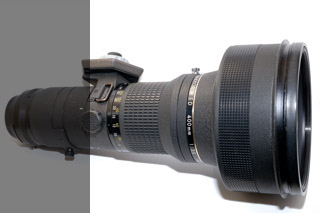
AI-S 400mm 3.5 ED-IF
A massive construction to last a lifetime – like with all professional Nikkors. About 12.000 lenses were made from the beginning of the AI era throughout the AI-S times. In 2003 the lens was still listed on the Nikon website for a suggested retail price of 4799 €.
Ther optical quality is very good even wide open and improves just slightly as you stop down. All over all this is a very sharp lens and a joy to use. One bonus ist that it can be used together with a teleconverter with very good results. Right now I have used the lens with a Kenko 1,4 konverter while the Nikon TC-14B is still on the way and with the Nikon TC-301 2x. I was quite surprised with the 2x Nikon converter as it still delivers quite pleasant results which can be brought up to an excellent level in post processing. Highly recommended is also the (converted) TC-16A, wich is otherwise an average performer. On this lens it really shines and turns it into a practical long AF tele.
The handling of the lens is better than I first thought. It is very easy to judge sharpness from the viewfinder of a D700 and pictures just “snap” into focus. Beware that the whole setup is absolutely front-heavy due to the large front lens elements. Especially when unmounting the lens from a quick release mechanism make sure to support it at the front, otherwise the lens dips forward.
Despite the weight of 2,8 kg the lens handles very nicely and is quite manageable on a monopod with sturdy ballhead (a Manfrotto 488 for example doesn’t cut it). It is the only option if you want a compact 400mm lens as the newer 2,8 aperture versions weigh around 5 kg.
This time – due to bad weather for a consecutive number of weekends – a test-series indoors.
Sample (DX – D200): 400mm f3,5 400mm f4,0 400mm f5,6
Samples (DX – D200 plus Kenko TC 1,4x Pro): 400mm f3,5 400mm f4,0 400mm f5,6
Samples (DX – D200 plus Nikon TC-200 2,0x): 400mm f3,5 400mm f4,0 400mm f5,6
Samples (DX – D200 plus Nikon TC-301 2,0x): 400mm f3,5 400mm f4,0 400mm f5,6
Samples (FX – D700 plus Nikon TC-200 2,0x): 400mm f3,5 400mm f4,0 400mm f5,6
Samples (FX – D700 plus Nikon TC-301 2,0x): 400mm f3,5 400mm f4,0 400mm f5,6
Samples in the field (FX – D700): 400mm f3,5 400mm f5,6 400mm f5,6 with Kenko 1,4x 400mm f5,6 with TC-301
Samples (FX – 36MP): 400mm f3,5 400mm f5,6 400mm f3,5 with TC-14B 400mm f5,6 with TC-14B

F Nikkor UC-1 focusing system
The initial batch of super-tele lenses for the Nikon F system was brought to market during the 60’s, especially for the Olympics in 1964 in Tokyo to be exact.
While having covered the focal lengths up to 200mm at that point, longer lenses were missing from the lineup. Introduced were fix focal lenses of 300mm (4,5), 400mm (4,5), 600mm (5,6) , 800mm (8,0) and a whopping 1200mm (11,0).
From the new lenses only the 300mm 4,5 got a traditional lens design. The longer lenses shared a special construction. The lenses at 400/600/800/1200mm were split into two parts, consisting of a focusing and an optical part. The focus section CU-1 was the same for all the lenses and was connected via a screw mount to the optical head and had no wond optical elements. In later years the focus part was revised, cosmetically refreshed and sold under the name AU-1, just before all lenses were replaced with a more modern single-body design with improved optics inside.
The CU-1 offers an automatic spring-aperture, but has no metering index to the camera, so the meter in the camera knows nothing about the selected aperture. Either the manual exposure setting or exposure compensation has to be used.
Nikon was not the only company offering two-part lenses. For example Canon had similar designs in the lineup. However, the mechanical construction had a few disadvantages. Lenses got longer than needed and the minimum focus distance increased at longer focal lengths, because the focus extension is not long enough for longer lenses. In case of the CU-1 the build quality is also an issue. The shorter tele heads up to 800mm offer no own tripod mount and so the weight of the 400mm and 600mm heads is dragging down on the tube of the CU-1. This leads in turn to a stiff focus ring (which is smooth without load). Nikon fixed the flaw by offering a separate tele head support that screws into the tripod mount of the CU-1 and gives suopport to the lele head. But even with the 1200mm head where a second tripod foot is included the weight of a D700 with grip is enough to flex the CU-1 body a bit, therefore the focus becomes harder.
The optic heads were rather simple constructions without efforts to reduce lens size, which lead to big and long lenses where the length of the lens almost equals the focal length. Aimed at professional photojournalists the build quality was superb and from the optical point of view the lenses were state-of-the-art. However, since ED glass was introduced in the 70’s they don’t match the performance of more modern variants.
The price of the 1200mm 11,0 tele head was 950 US $ in 1967. The CU-1 focus unit came on top of that at 199$. Those figures seem to be rather low, but inflation adjusted to 2016 prices this equates to 6864 $ and 1438 $.
All lens heads were in production for about ten years, before they got replaced by single-part lenses in the middle of the 70’s. The 600mm, 800mm and 1200mm were even updated to ED glass towards the end of their lifetime. Production volumes were rather low on all variants. No lens achieved more than 3000 copies. The 600mm was the most popular with almost 3000 produced units, followed by the 400mm with around 2200 units. More rare are the 800mm and 1200mm with a bit more than 1150 copies.
Before we come to the more practical part, first a warning: THE FOCUS MOUNT CU-1 IS NOT COMPATIBLE WITH ALL MODERN DSLRs! Yes, you can mount it, with a bit of luck and depending on the camera model you might even be able to use it, but there is a chance that it will at least cosmetically damage the mirrorbox! The reason is that the aperture lever extends over the bayonet mount. It has a very special movement. If you are lucky the lever just jams against the small plastic block inside the cameras bayoent mount left of the aperture actuator and will not stop down when you take a picture. In certain situations I can imagine that it somehow even damages the aperture actuating lever while taking a picture. So, please modify the CU-1 before you use it by removing material from the aperture lever on the CU-1:
Lever filed down: lever filed down 1 and lever filed down 2
Otherwise – in the best case – this small cosmetical damage can occur in the mirrorbox right beside the apterture actuator (on D300): damage on the D300
For all heads – even the 400mm one – at tripod is almost mandatory. the weight of the overall setup and the rather hard focusing of the CU-1 makes handholding almost impossible.
Reviewed here is the longest of the lens heads coupled with the older CU-1 focus unit:

Nikkor P 1200mm 11,0
The longest fix-focal in the Nikon lineup is also the longest lens in size that Nikon ever produced (including the CU-1). A whopping 922mm makes this lens seem endless. The diameter of 134mm and filter size of 122mm is relatively moderate thanks to the low speed of f/11. Coupled with a total weight of around 4,5 kg this lens is more than difficult to handle. Metering through the closed aperture of the tele head as there is no coupling or spring connected to the camera. Manual setting of shutter time is recommended, my D700 went a bit crazy in A-mode.
Unlike the other tele heads this one comes with his own aperture. The aperture on the CU-1 has to be set to f/4,5, otherwise vignetting will occur. This is also important if a macro ectension ring should be used in order to bring down the minimum focus distance. Some extension rings come with central rectangular cutouts in a metal frame in the middle of the tube. This lens needs a round opening and the travelling light utilizes the whole diameter of the f-mount.
Three factors are limiting this lens: Low speed, massive minimum focus distance at 43m and the focal length itself. The low speed is liming, but at the same time a benefit, since the lens does not get much heavier and at physically not manageable. With the recent high resolution sensors f/11 puts you right into diffraction territory. The close focus distance is mostly attributed by the universal focus unit. A specialised focus system matched to the lens would bring the distance down. Ironically the huge focal length is a hindrance. It is a technical challange to get a sharp, vibration-free picture out of a lens like this. The dark viewfinder at f/11 and therefore the loss of the focus indicator are a major challange, too.
Since this is the fist version – and in some ways part of the initial Nikkor F lineup belonging to the Nikon F – we are talking about the beginning of the lens evolution. According to the designation it is even lacking Nikons special coating NIC, which got introduced in the second production version, known as Nikkor PC 1200mm 11. Nevertheles expectations shouldn’t be too low. This was a professional optic with a corresponding pricetag and represented the technical possibilities of the 1960s.
A focal length of 1200mm brings various factors into play regarding the picture quality. First, there are the obvious things that form the foundation for sharp pictures. You need a massive tripod, a camrea with the possibility to swing the mirror up before taking the picture (D200 and up) and a cable or wireless release. Second, there is one thing that is now very important: the quality of the air. Obviously humidity or fog are always degrading picture quality on long distances, but even in shorter ranges you will notice differences with this lens. Turbulences in the air become appartent.
The optical testing of this lens will take a long time. Don’t expect that the rating-boxes below will be filled with content any time soon. Taking this lens out requires a lot of work and the right motives. Nevertheless I can share my first impressions on optical quality.
So far I have tested the lens only on the D700. If all conditions are met the lens is already sufficiently sharp at f/11. Picture quality and especially contrast increases a bit at f/16 accompanied with a slight increase in sharpness. You can stop down to f/22 on the D700 without loosing picture quality. Diffraction limits this lens only at really small apertures of f/32 and down. This is due to the larger physical opening of the aperture and the fact that it sits relatively far away from the sensor. Color fringing is present at f/11, but not so much as the theoretical technical inferiority without NIC coating and ED glass would suggest. To sum it up: Right now I am satisfied with the results every time I manage to get a sharp picture.
It is possible to sue this lens with teleconverters and so far I have only tested the TC-14B, which brings the lens to 1680mm. The lens delivers acceptable and barely usable results at f/11. Stopping down to f/16 improves the situation and at f/22 picture quality is quite good for such a long combo. So far I have not tried the 2x converter TC-301 on this lens, but the focus will for sure become a pain at a viewfinder brightness of f/22. And seriously: who is so desperate to need 2400mm? 🙂
Below are my first quickly shot samples from this lens (more samples below). All of them were shot under insufficient light on a cloudy day with high ISO values on the D700. So, please take them only as the technical demonstration that this lens works. Better samples will be posted below the ratings once I have some (EXIFs are wrong, btw.):
D700, 1200mm, f/11, ISO 3200
D700, 1200mm, f/16, ISO 3200
D700, 1200mm, f/22, ISO 3200
D700, 1200mm, f/11, ISO 1600 pushed by 0,5 stops in Capture NX2. So this is rather noisy.
One could seriously ask the question what the practical purpose of such a lens is. It is not for birders (setup and critical focus takes too long, in this version the minimum focus distance is way too long). It is a speciality lens when you need to get far away and mostly static objects closter in the frame. And last but not least: Everybody’s attention is on your side if you are leaving the house with this gun. No matter if you like it or not!
Samples (FX – 12 MP): 1200mm f11 1200mm f16 1200mm f22 1200mm f32
1200mm f11 with TC-14B – 1680mm 1200mm f16 with TC-14B – 1680mm 1200mm f22 with TC-14B – 1680mm 1200mm f32 with TC-14B – 1680mm
